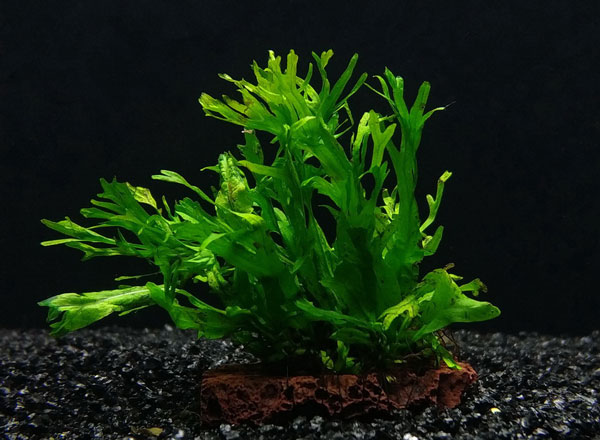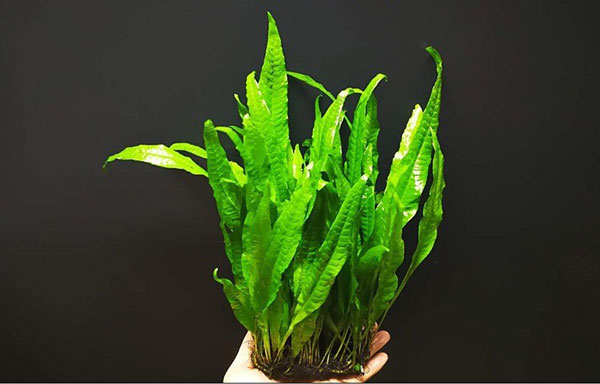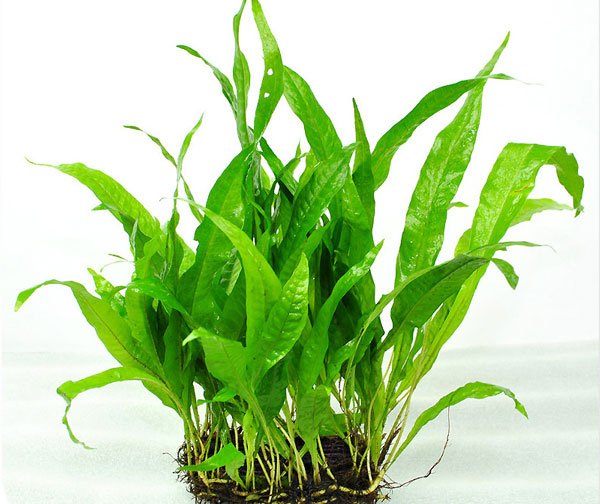Java Fern Care & Growing Guide
Written by Iris
Jan 28 2023

Java Fern is a kind of fern artificially improved from Iron Crown Plant. The leaf of Java Fern is long and slender, and is generally cultivated underwater as a landscaping aquatic plant in an artificial breeding environment, and it can also be cultivated on land in a high-humidity environment. Learn more about how to grow and care for Java Fern.
These java fern plants are one of the most popular plants in the aquatics trade, so they are easy to come by online and in person. Their popularity means they are usually carried by online stores, local stores, and big-name pet stores.
To grow new Java fern plants, you can either cut the rhizome in half and replant the cutting or develop the new plant from young leaves that develop under older leaves.
The young leaves usually start as black-spots on a mature plant.
New plants from propagates should start showing signs of growth 2 to 3 weeks after introduction to a fish tank. Just remember to tie the new plant to make it firm and give it ample area to spread.
Generally speaking, the growing medium of java ferns which is most common for these aquarium plants is either pieces of wood or large rocks. On occasion, it has been attached to decorative features made for fishtanks.
Rather than planting Java Ferns in the substrate of the tank, it’s advised that you loosely secure your java ferns on driftwood or rocks with a piece of cotton thread. This keeps the roots in contact with the growing medium until it can develop a firm grip, and the thread will eventually rot away.
As for myself, I dose my tanks twice a week with the recommended amount of Flourish and have seen great results.
When I first got into live plants, I thought that my lights were too weak to even grow Java fern. It didn’t die or anything, but it didn't really grow either.
But then I started adding the liquid fertilizer and the ferns and my other plants started going crazy. The Java fern will still grow more slowly than other kinds of plants, but you'll start to notice a major difference from month to month.
Pruning in that fashion will in time result in a much larger plant overall, as the rhizome will have enough time to develop a larger base from which to send up leafy growth.
If java fern melt begins to appear, remove damaged leaves immediately by pruning them off just above the rhizome.
Also, most herbivorous fish that would normally eat live plants tend to stay away from Java fern because it’s tough and unappealing.
The only parts of the plant you would need to worry about are the roots especially in younger Java fern plants because they tend to be tender. So keep an eye out every once a while until the plants are fairly hardy.
Moreover, with younger plants you’ll want algae eaters and sucker fish to ensure algae doesn’t out-compete your Java fern for nutrients.
In case you are having a serious algae problem on your plants, take some leaves and start them in a different tank or a container with water and access to light. Once they start to develop, reintroduce them in the tank to form new plants with no algae.
Java Fern melting is caused by cyanobacteria or blue, green algae growing in your tank. This is caused by a lack of nutrients in the water. If you find this is the case, you must clean and peel away the film of cyanobacteria from your ferns and other aspects of your tank. Do a partial water change of 25 to 50% and give your plants a dose of fertilizer. Be sure to keep nutrition levels high so cyanobacteria will not return. Remember a lack of fertilizer alone can cause Java Fern to melt.
Too much salt in the water may also cause leaf melt. Be careful not to use too much fertilizer as this can cause salt buildup, cloudy water, promote algae growth, and may even cause Java Fern melt.
Ming Fern (Asparagus Myriocladus) Profile: Care & Growing Guide
Java Fern Care & Growing Guide
Blue Star Fern Care: How to Grow & Care for Phlebodium Aureum
How to Grow & Care for Asparagus Fern
Maidenhair Fern (Adiantum raddianum) Grow & Care Guide
Birds Nest Fern (Asplenium Nidus) Profile: Info, Care & Growing Guide
How to Grow and Care for Kimberly Queen Fern
Rabbit Foot Fern Care & Propagation Guide
Staghorn Fern (Platycerium Bifurcatum) Care & Growing Guide
Japanese Royal Fern (Osmunda Japonica) Profile
Where to Find Java FernJava Fern PropagationJava Fern CareJava Fern Lighting RequirementsJava Fern Soil CareJava Fern Substrate CareJava Fern Temperature RequirementJava Fern Fertilizer CareJava Fern Care - FiltrationJava Fern Care - PruningJava Fern Tank RequirementsJava Fern TankmatesJava Fern DiseasesJava Fern Varieties
Where to Find Java Fern
Java Ferns are native to Southeast Asia, having received their name from the island of Java in Indonesia. They thrive in high-humidity environments, particularly those with low or moderate lighting. They are often seen growing in and around waterfalls.These java fern plants are one of the most popular plants in the aquatics trade, so they are easy to come by online and in person. Their popularity means they are usually carried by online stores, local stores, and big-name pet stores.
Java Fern Propagation
Propagating Java fern is easy, sometimes all it takes is throwing the plant in your water, and the plant will start growing. As long as it’s floating or attached to driftwood or rocks, the plant will grow.To grow new Java fern plants, you can either cut the rhizome in half and replant the cutting or develop the new plant from young leaves that develop under older leaves.
The young leaves usually start as black-spots on a mature plant.
New plants from propagates should start showing signs of growth 2 to 3 weeks after introduction to a fish tank. Just remember to tie the new plant to make it firm and give it ample area to spread.
Java Fern Care
Java Fern Lighting Requirements
Aquarists differ on whether Java Fern requires bright or dim light. Intense light may burn leaves and result in brown or transparent spots which you’ll need to prune. Reduce brightness with small incandescent bulbs or softer fluorescent ones. Java fern is one of the best plants for a low-light aquarium. The Java fern needs 1.5 watts of light for each gallon of water, and 5000-7000 K bulbs work efficiently on most tanks.Java Fern Soil Care
Java Ferns are epiphytic, like Spanish moss or many bromeliads. It does not require soil at all to live, and in fact prefers its roots to be fully exposed and not buried at all.Generally speaking, the growing medium of java ferns which is most common for these aquarium plants is either pieces of wood or large rocks. On occasion, it has been attached to decorative features made for fishtanks.
Rather than planting Java Ferns in the substrate of the tank, it’s advised that you loosely secure your java ferns on driftwood or rocks with a piece of cotton thread. This keeps the roots in contact with the growing medium until it can develop a firm grip, and the thread will eventually rot away.
Java Fern Substrate Care
Java Ferns should not be planted in substrate. They naturally grow attached to roots, driftwood, and rocks. In aquariums, these plants may need to be attached to porous surfaces by string or aquarium-safe plant glue. This will allow the rhizomatic roots to take hold of the surface. Once anchored, Java Ferns can be difficult to move, so ensure you are placing the plant on an item you intend to keep. (Read More:How to Plant a Java Fern in Aquarium)Java Fern Temperature Requirement
Java Fern is a tropical plant thriving in temperatures ranging from 70° – 75° degrees Fahrenheit (21° – 24° C), but it can tolerate temperatures as low as 60° degrees Fahrenheit (15° C) and as high as 83° degrees Fahrenheit (28° C).Java Fern Fertilizer Care
You don't have to use fertilizer with Java fern. But, it will grow much more quickly if you use a liquid fertilizer like Seachem Flourish or API Leaf Zone.As for myself, I dose my tanks twice a week with the recommended amount of Flourish and have seen great results.
When I first got into live plants, I thought that my lights were too weak to even grow Java fern. It didn’t die or anything, but it didn't really grow either.
But then I started adding the liquid fertilizer and the ferns and my other plants started going crazy. The Java fern will still grow more slowly than other kinds of plants, but you'll start to notice a major difference from month to month.
Java Fern Care - Filtration
Java Ferns do not have specific filtration needs. They will grow in low to moderate currents and will happily consume nitrate in the water.Java Fern Care - Pruning
Occasional light pruning encourages plant development. Remove larger leaves just above the rhizome to give it more energy to put towards growth. Don’t take too many off, but select just one or two of the largest leaves.Pruning in that fashion will in time result in a much larger plant overall, as the rhizome will have enough time to develop a larger base from which to send up leafy growth.
If java fern melt begins to appear, remove damaged leaves immediately by pruning them off just above the rhizome.

Java Fern Tank Requirements
Tank size is important for your Java Fern. These plants can get quite large. A standard Java Fern can grow up to a foot tall and sometimes over this. Some Ferns are smaller of course, but you want to have enough room for your plant and pet. So in general, never get an aquarium that is under ten gallons when planting a Java Fern. Small tanks will become overcrowded with this plant rather easily. Java Ferns are not a fast-growing plant but they do get tall. After you get the correct tank size for your Java Fern, you’ll need to adjust the water to your plant's needs.
Java Fern Tankmates
Java fern is hardy hence compatible with a huge variety of fish and is even resistant to most snails that nibble on other aquarium plants.Also, most herbivorous fish that would normally eat live plants tend to stay away from Java fern because it’s tough and unappealing.
The only parts of the plant you would need to worry about are the roots especially in younger Java fern plants because they tend to be tender. So keep an eye out every once a while until the plants are fairly hardy.
Moreover, with younger plants you’ll want algae eaters and sucker fish to ensure algae doesn’t out-compete your Java fern for nutrients.
In case you are having a serious algae problem on your plants, take some leaves and start them in a different tank or a container with water and access to light. Once they start to develop, reintroduce them in the tank to form new plants with no algae.

Java Fern Diseases
Too much light will cause your Java to experience a condition known as Java Fern melt. When this happens, brown or clear blemishes will appear on the leaves, and the plant will eventually disintegrate and die. Remember Microsorum is a low light plant and excessive sunlight will kill it. If you’re using artificial lighting, 1.5 W per gallon of aquarium or pond water is desirable. Even this small amount of light may be too much, and you may choose instead to backlight your aquarium rather than using overhead lighting. In this case, low light LED lights are preferable. If you determine excessive light is the cause of your problem, you must prune off damaged leaves and then turn off your aquarium lights and cover the tank with a towel or blanket for three days to give the plants a chance to recover. In an outdoor setting, you must prune back damaged parts of your plants and then determine a way to provide more shade. In upon setting, you may set up an umbrella or shade cloth and possibly move potted plants around the edges of the pond to shade it.Java Fern melting is caused by cyanobacteria or blue, green algae growing in your tank. This is caused by a lack of nutrients in the water. If you find this is the case, you must clean and peel away the film of cyanobacteria from your ferns and other aspects of your tank. Do a partial water change of 25 to 50% and give your plants a dose of fertilizer. Be sure to keep nutrition levels high so cyanobacteria will not return. Remember a lack of fertilizer alone can cause Java Fern to melt.
Too much salt in the water may also cause leaf melt. Be careful not to use too much fertilizer as this can cause salt buildup, cloudy water, promote algae growth, and may even cause Java Fern melt.

Java Fern Varieties
- Narrow Leaf Java Fern: This Java Fern variety has narrow leaves, which grow at a steeper angle than the regular Microsorum pteropus. Leaves grow to around 4-8 inches and the plant can grow as high as 12 inches.
- Needle Leaf Java Fern: This Java Fern variety has even thinner leaves, and is smaller than the narrow leaf plant. It can grow to heights of 6 inches. True needle leaf Java is fairly rare in the trade.
- Trident Java Fern: This is one of the more uncommon variety, it has feathery lobed leaves with 2-5 lobes on each side of its leaves. It is shorter than the narrow leaf, but grows quicker, and has more forks in each leave.
- Windelov Java Fern: A unique Java Fern variety with finely branched leaf tips. It usually grows to around 8 inches tall.
Ming Fern (Asparagus Myriocladus) Profile: Care & Growing Guide
Java Fern Care & Growing Guide
Blue Star Fern Care: How to Grow & Care for Phlebodium Aureum
How to Grow & Care for Asparagus Fern
Maidenhair Fern (Adiantum raddianum) Grow & Care Guide
Birds Nest Fern (Asplenium Nidus) Profile: Info, Care & Growing Guide
How to Grow and Care for Kimberly Queen Fern
Rabbit Foot Fern Care & Propagation Guide
Staghorn Fern (Platycerium Bifurcatum) Care & Growing Guide
Japanese Royal Fern (Osmunda Japonica) Profile
Latest Updated
- Benefits of Bugleweed - 7 Science-backed Health Benefits
- Bugleweed Dangers & Side Effects - Is It Poisonous?
- How to Plant Evergreen Trees - What You Should Know
- When to Plant Evergreens - Grow Guide for Evergreen Trees
- 12 Wonderful Evergreen Shrubs for Your Garden
- 12 Popular Evergreen Plants with Pictures for Beginners
- When And How To Prune A Lilac Bush Like a Pro
- How to Grow & Care for Lilac Vine (Hardenbergia Violacea)
- Japanese Lilac Tree (Syringa Reticulata) Care & Propagation Guide
- Shumard Oak Pros and Cons - What to Know
Popular Articles
- Winter maintenance of Antirrhinum Majus
- How to Grow Terminalia Mantaly Tree
- How to Grow and Care for Crossostephium Chinense
- How to grow Antirrhinum Majus in spring
- Peristeria Elata (Dove Orchid) Profile: Info & Care Guide
- Underwatered Snake Plant (Sansevieria Trifasciata) - Signs And How To Fix
- How to Care for Brazilian Jasmine Plant (Mandevilla Sanderi)
- How to Grow & Care for Graptopetalum Purple Delight in Summer
- Rosa Chinensis (China Rose): Plant Growing & Care Tips
- How to Care for Baby Sun Rose (Aptenia Cordifolia)